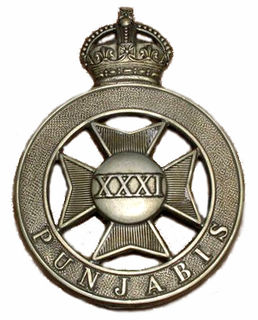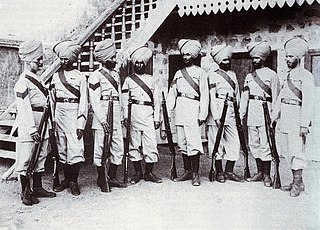
The 17th Dogra Regiment was an infantry regiment of the British Indian Army. It was formed in 1922, after the Indian government decided to reform the army moving away from single battalion regiments to multi-battalion regiments. After the partition of India in 1947, it was allocated to the new Indian Army and renamed the Dogra Regiment.
The 41st Dogras were an infantry regiment of the British Indian Army. They could trace their origins to 1900, when they were raised as the 41st (Dogra) Bengal Infantry.
The 1st Brahmans was an infantry regiment of the British Indian Army. It was raised at Oudh by Captain T Naylor in 1776 for service in the army of Nawab Wazir of Oudh, and was known as the Nawab Wazir's Regiment. It was transferred to the East India Company in 1777. In 1922, it was designated as the 4th Battalion 1st Punjab Regiment. The regiment was disbanded in 1931.

The 13th Rajputs was an infantry regiment of the Bengal Army, and later of the British Indian Army. They could trace their origins to the Shekhawati Regiment raised in 1835, as part of the Jaipur contingent of the Honourable East India Company and were taken into the Company's service as a local battalion 8 years later. They fought in the Battle of Aliwal in the First Anglo-Sikh War. Remaining loyal during the Indian Rebellion of 1857, they were taken into the Bengal Army as the 13th Bengal Native Infantry in 1861. There followed a number of different name changes the 13th (Shekhawati) Bengal Native Infantry 1884–1897, the 13th (Shekhawati) Rajput Regiment of Bengal Infantry 1897–1901, the 13th (Shekhawati) Rajput Infantry 1901–1903. Then finally in 1903, after the Kitchener reforms of the Indian Army the 13th Rajputs . During World War I they were part of the Imperial Service Infantry Brigade assigned to the Indian Expeditionary Force B that was sent to British East Africa. They fought at the Battle of Tanga.

The 11th Rajputs was an infantry regiment of the Bengal Army and later of the British Indian Army. They could trace their origins to 1825, when they were the 2nd Extra Battalion, Bengal Native Infantry. In 1828 they were renamed the 70th Bengal Native Infantry and a number of changes in name followed the 11th Bengal Native Infantry 1861–1885, the 11th Bengal Infantry 1885–1897, the 11th (Rajput) Bengal Infantry 1897–1901, the 11th Rajput Infantry 1901–1903. Finally in 1903, after the Kitchener reforms of the Indian Army the 11th Rajputs.
The 16th Rajputs was an infantry regiment of the Bengal Army and later of the united British Indian Army. It can trace its origins to 1857, during the Indian Mutiny when it was formed from men of the 13th, 48th and 71st Bengal Native Infantry regiments that remained loyal to the British. Named The Lucknow Regiment they were responsible for guarding the Bailey Gate in the Lucknow Residency. Over the years they were known by a number of different titles the 16th Bengal Native Infantry in 1861, the 16th Bengal Native Infantry 1864, the 16th Bengal Infantry 1885, the 16th Rajput Bengal Infantry 1897, the 16th Rajput Infantry 1901 and finally after the Kitchener reforms of the Indian Army the 16th Rajputs.
The 14th King George's Own Ferozepore Sikhs was a regiment of the British Indian Army; they can trace their origins to the Regiment of Ferozepore formed in 1846. The regiment had a number of different titles over the following years: the 14th Bengal Native Infantry 1861–1864, the 14th Regiment of Bengal Native Infantry 1864–1885, the 14th Regiment of Bengal Native Infantry 1885–1901, the 14th (Ferozepore) Sikh Infantry 1901–1903 and finally, after the Kitchener reforms of the Indian Army in 1903, the 14th Ferozepore Sikhs.
The 10th Jats were an infantry regiment of the British Indian Army. They could trace their origins to 1823, when they were known as the 1st Battalion, 33rd Bengal Native Infantry. Over the years they became known by a number of different titles. The 65th Bengal Native Infantry 1824–1861, the 10th Bengal Native Infantry 1861–1885, the 10th Bengal Infantry 1885–1897, the 10th Jat Bengal Infantry 1897–1901, the 10th Jat Infantry 1901–1903 and finally in 1903 the 10th Jats.

The 36th Sikhs was an infantry regiment in the British Indian Army. They could trace their origins to 1887, when they were the 36th (Sikh) Bengal Infantry. Composed of Jat Sikhs, it was created by Colonel Jim Cooke and Captain H. R. Holmes. They had one other change in title in 1901, when they became the 36th Sikh Infantry. They finally became the 36th Sikhs in 1903, after the Kitchener reforms of the Indian Army. During this time they fought an action in 1897, in defence of the Samana Ridge against a huge army of Pathans in the Battle of Saragarhi. To honour the visit of the Prince and Princess of Wales to India they took part in the Rawalpindi Parade 1905. During World War I they were stationed as part of the Garrison of Tianjin in China and took part in the Siege of Tsingtao.
The 17th Infantry was an infantry regiment of the Bengal Army, later of the united British Indian Army. It was formed at Phillour in 1858 by Major J. C. Innes from men of the 3rd, 36th and 61st Bengal Native Infantry regiments who remained loyal to the British East India Company during the Indian Mutiny, and designated The Loyal Purbiah Regiment.
The 18th Infantry were an infantry regiment of the British Indian Army. They could trace their origins to 1795, when they were called the Calcutta Native Militia. Over the years they were known by a number of different name The Alipore Regiment in 1859, the 18th Bengal Native Infantry in 1861, the 18th (Alipore) Bengal Native Infantry in 1864, the 18th Regiment of Bengal Native Infantry in 1885, the 18th Musulman Rajput Infantry in 1902. Finally following the Kitchener reforms of the Indian Army the 18th Infantry.

The 23rd Sikh Pioneers were a regiment of the British Indian Army. They could trace their origins to 1857, when they were known as the 15th (Pioneer) Regiment of Punjab Infantry. The regiment recruited exclusively from the Mazhabi Sikh community of Punjab province. Despite being "pioneers" by name, the regiment functioned as a Sikh infantry regiment specially trained as assault pioneers.

The 26th Punjabis were an infantry regiment of the British Indian Army. It was raised in 1857, as the 18th Regiment of Punjab Infantry. It was designated as the 26th Punjabis in 1903 and became 2nd Battalion 15th Punjab Regiment in 1922. In 1947, it was allocated to the Pakistan Army, where it continues to exist as 10th Battalion The Punjab Regiment.

The 30th Punjabis were an infantry regiment of the British Indian Army. It was raised in 1857, as the 22nd Regiment of Punjab Infantry. It was designated as the 30th Punjabis in 1903 and became 1st Battalion 16th Punjab Regiment in 1922. In 1947, it was allocated to the Pakistan Army, where it continues to exist as 13th Battalion The Punjab Regiment.

The 31st Punjabis was an infantry regiment of the British Indian Army. It was raised in 1857, as Van Cortlandt's Levy. The regiment was designated as the 31st Punjabis in 1903 and became 2nd Battalion 16th Punjab Regiment in 1922. In 1947, it was allocated to the Pakistan Army, where it continues to exist as 14th Battalion The Punjab Regiment.

The 34th Royal Sikh Pioneers was an infantry regiment of the British Indian Army. They could trace their origins to 1857, when they were raised as the Punjab Sappers. The regiment recruited exclusively from the Mazhabi Sikh community of Punjab province. Despite being "pioneers" by name, the regiment functioned as a Sikh infantry regiment specially trained as assault pioneers.

The 35th Sikhs were an infantry regiment of the British Indian Army. They could trace their origins to 1887, when they were raised as the 35th (Sikh) Bengal Infantry.
The 37th Dogras was an infantry regiment of the British Indian Army. The regiment could trace its origins to 1887, when it was raised as the 37th (Dogra) Bengal Infantry.

The 45th Rattray's Sikhs was an infantry regiment of the British Indian Army. They could trace their origins to the 1st Bengal Military Police Battalion raised in April 1856, at Lahore, by Captain Thomas Rattray originally consisting of a troop of 100 cavalry and 500 infantry. The initial class composition of the troops was 50% Sikhs and 50% Dogras, Rajputs and Mussulmans (Muslims) from the Punjab and the North-West Frontier. It is said that he went through the villages challenging men to wrestle with him on the condition that they had to join up. Whatever the case, the regiment was raised and trained and developed as an elite corps, which soon saw action in Bihar in the Sonthal 'purghanas'. After sterling service in Bihar, Bengal and Assam, and during the 1857 Mutiny, the cavalry portion was eventually disbanded in 1864 and the infantry section was taken into the line of Bengal Native Infantry as the '45th Native Regiment of Infantry'.

The 47th Sikhs were an infantry regiment of the British Indian Army. They could trace their origins to 1901, when they were raised as the 47th (Sikh) Bengal Infantry.











